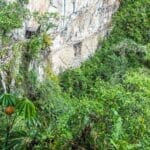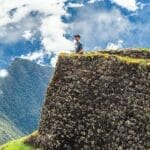Dear reader: This article contains links to products and services that I may be compensated for, at no extra cost to you.
A lot of travelers hate Aguas Calientes. They’ll tell you to get out as soon as possible. But guess what. I quite enjoyed it!
Aguas Calientes means “Hot Waters”, after the hot springs in town. Also called Machu Picchu Pueblo or Machu Picchu Village, it is 100% a tourist town created solely to cater to tourists visiting Machu Picchu.
Still, Aguas features some lovely public art, waterfall hikes, and an impressive butterfly sanctuary. It is mostly traffic free and surrounded by stunning scenery. Why not treat yourself to a fine meal, some craft beers, and perhaps a hot spring soak after your Inca Trail hike or Machu Picchu visit, before rushing back to Cusco or the Sacred Valley?
If you’re visiting Machu Picchu, there’s a very high chance you’ll be passing through Aguas Calientes on the way in and/or out. Most visitors just rush through, or at best stay one night before or after their trek.
If you have the room in your itinerary, I actually recommend staying in Aguas Calientes for two nights! This is what I did, and I don’t regret it!
Table of Contents
Getting to Aguas Calientes
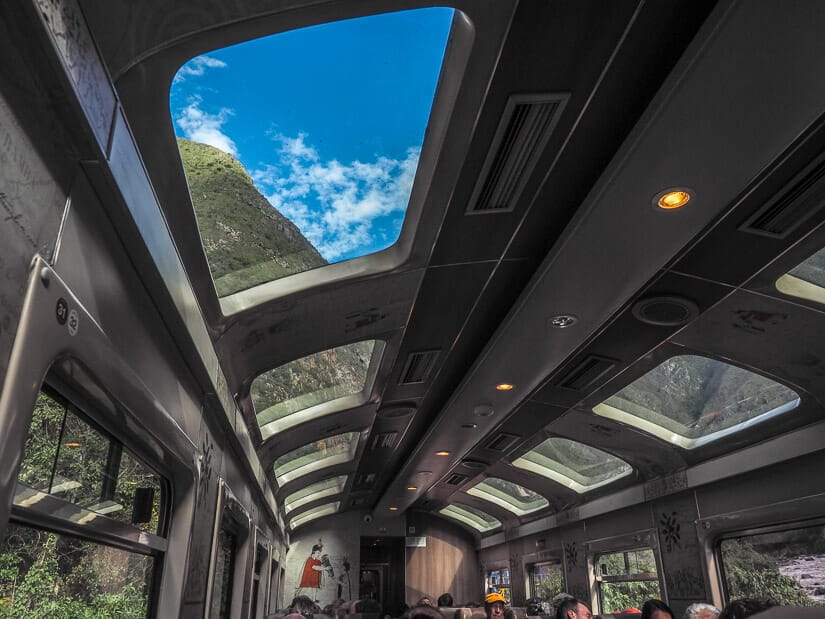
The is no road or public transportation to Aguas Calientes besides the train.
The vast majority of tourists come to Aguas Calientes by one of two ways. The first and most common is by tourist train from Poroy (near Cusco) or Ollantaytambo. These trains start at a ridiculously overpriced USD 140 for the round-trip from Cusco (locals, by contrast, pay $6).
If you’re going by organized tour, your tour company will most likely arrange the train ticket for you. If you need to buy it on your own, here’s a detailed guide.
The second most common way is to hike to Machu Picchu on the Inca Trail, then take the train out from Aguas Calientes. Those on the 4-Day Inca Trail will hike directly to Machu Picchu then take the bus down to Aguas Calientes after and train out. Those on 1-Day, 2-Day, 5-Day Inca Trails, or other alternative trails, will mostly spend a night first in Aguas Calientes before visiting Machu Picchu by bus the next day, then taking the train out.
It’s also possible to get to Aguas Calientes without taking the super overpriced tourist train. This involves taking a colectivo to Hydroelectrica (a hydroelectric dam west of Machu Picchu) and walking two hours along the train tracks. Find out how to do it here.
You’ll pass Mandor (which I’ll cover in the final section of this article) and the trailhead of the hike to Machu Picchu before reaching Aguas Calientes.
Finding Your Way Around Town
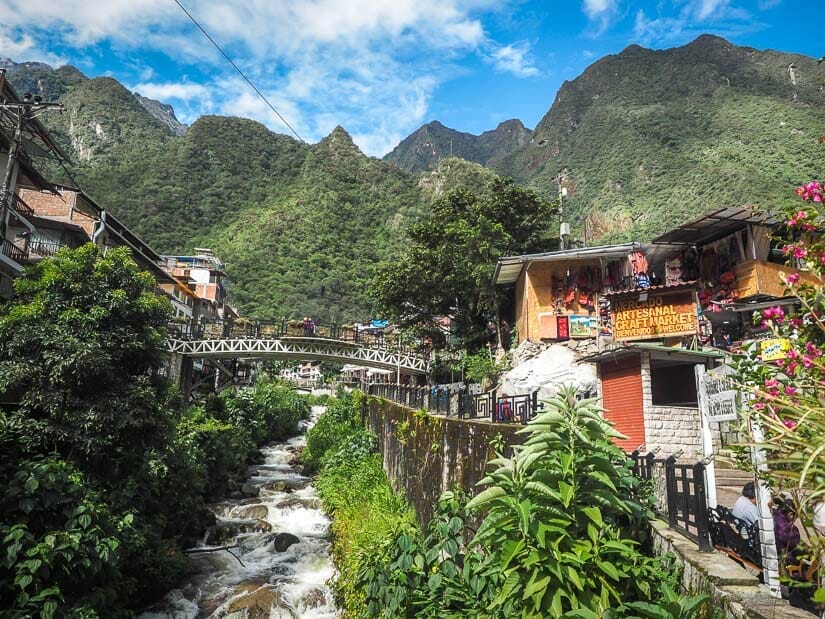
Aguas Calientes lies at the confluence of three rivers. The Urubamba River (which forms the Sacred Valley and flows around Machu Picchu) flows along the west side of town, with many hotels and restaurants looking over it. The smaller Alcamayo River is south of town (with a cool waterfall hike that I’ll cover below!).
Lastly, the Aguas Calientes River splits the town into northern and southern halves (see image above).
The train station is located just south of the Aguas Calientes River, to the right of the maze-like Mercado Artesenal (tourist market) in the above photo. To leave the station, you have to find your way though the market.
If you’re going directly to Machu Picchu, you’ll need to cross the bridge to the north side of the river. I took the above photo from that bridge! Then buy your bus ticket here and line up for the bus between here and here.
If you didn’t buy your Machu Picchu ticket yet, don’t fret. They sell as additional 1000 tickets per day in Aguas Calientes at the Ministry of Culture office here. You can buy tickets for the next day, or even on the same day as your visit (subject to availability). At peak times, the line can be very long. But when I did this in the slow season, there was no line at all.

Hotels are spread out in the southern and northern sides of town. Overall, the northern side has more restaurants and tourist amenities. More locals live on the quieter southern side of town, east of the train station, around the large Football Field.
While most tourists get on/off the train at the train station just south of the Aguas Calientes River, some trains continue right through town. Thus, Aguas Calientes has a train town feel, with many restaurants and businesses lining the tracks. You’ll see and hear trains all the time, and often find yourself walking across the tracks.
If you want to avoid the pricey bus ticket, it’s possible to walk from Aguas Calientes to Machu Picchu in around two hours. This involves a 20-minute walk from Aguas Calientes to the trailhead, and then a steep uphill hike of around 1 hour 40 minutes.
You’ll need to show your Machu Picchu entrance tickets at the bridge just before the trailhead, and you can’t enter more than 2 hours before your ticket time.
Where to Stay in Aguas Calientes
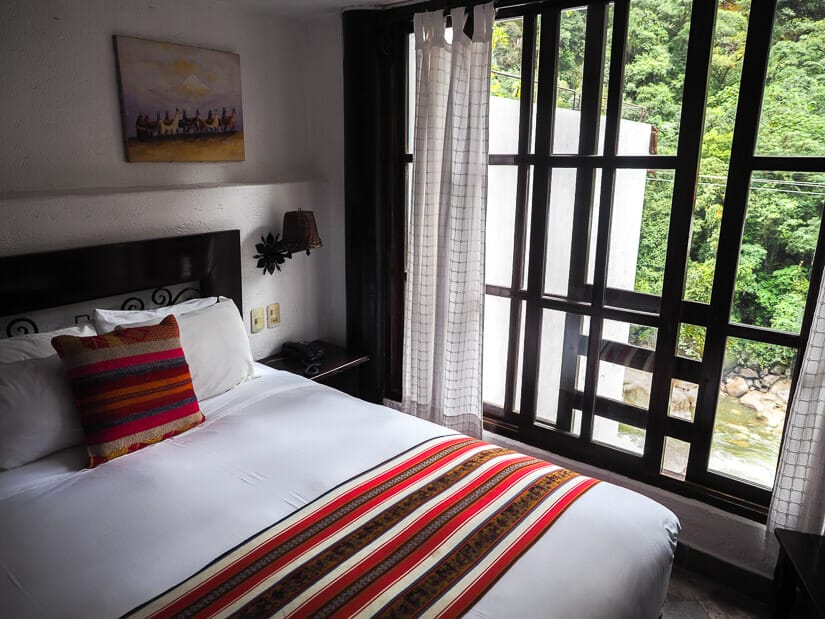
For my two nights in Aguas, I stayed at Sacred Stone (see on Booking / Agoda / TripAdvisor). This was a lovely, quiet guesthouse right along the river at the western end of town – perfect for walking to Machu Picchu or Mandor (see end of article). It included a large breakfast (early morning take-away option available), powerful and hot shower (absolute must after the Inca Trail!), and a river view from my room.
For a classier stay, consider Casa del Sol Machupicchu (see on Booking / Agoda / TripAdvisor) or Inkaterra (see on Booking / Agoda / TripAdvisor). There’s also the Sanctuary Lodge (see on Booking / Agoda / TripAdvisor) right at Machu Picchu, but you’ll have to pay a lot for the convenience.
For budget travelers, I seriously considered staying at Eco Art (see on Booking / Agoda / TripAdvisor) for the low price and view, but you must know you’ll have to walk up some serious stairs to get there. There are also budget options near the train station, like Machupicchu Magna (see on Booking / Agoda / TripAdvisor).
Things to Do in Aguas Calientes Town Center
The following 10 sights are located in the tourist town of Aguas Calientes. You can see and do most or all of them in half a day.
If you spend 1 or 2 nights in Aguas Calientes, then make sure to read the following section, things to do outside of town, which are actually the area’s most worthwhile attractions.
Take a Selfie with Pachacutec
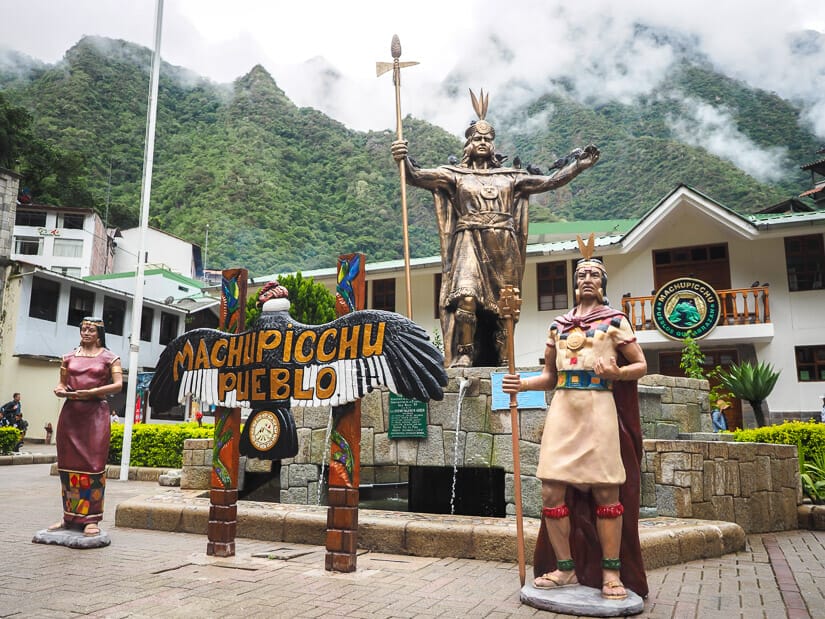
Plaza Manco Capac, also called Plaza Pueblo Machu Picchu, is the main square of Aguas Calientes. It is on the north side of town, with restaurant and bar-lined walking streets emanating out from it.
At the center of the square is a large statue of Pachacuti (Pachacutec), the builder of Machu Picchu. He stands upon a small water fountain, with other statues and Peruvian & Inca flags beside him (the Inca flag is the one that looks almost identical to the gay pride flag). Naturally this spot is a selfie station, so you may even have to wait in a line for your chance to take a shot.
On the square, you’ll also find a lovely little church (Parroquia Virgen del Carmen Church). The Ministry of Culture, for buying Machu Picchu tickets, is just down Ave Pachacutec.
Fun tip: You can get a free Machu Picchu stamp at the Ministry of Culture. Although many people like to put the stamp in their passport, you could face problems down the road if you do this.

Soak in the Baños Termales (Hot Springs)

Aguas Calientes takes its name from its hot springs, and they are one of the top attractions in town.
The hot springs facility, Baños Termales, isn’t great by Peruvian standards. There are many other better ones out there. The water could be a little hotter, and the water in the pools seems to get browner as the day goes on. Visit early for the best experience – it opens at 5 AM.
But unless you are actually planning to go to any other hot springs in Peru (not many visitors do), then this may be your only chance. Plus, a hot water soak after a long hike or Machu Picchu visit doesn’t hurt!
Despite the poor reviews, I though the hot springs were fine. There are a handful of pools with different temperatures, there’s cocktail service right to the pools, the facilities are clean, and the pools are in a picturesque little valley. There’s also a small bar/cafe with rasta vibe, and they were playing Bob Marley at the hot springs.
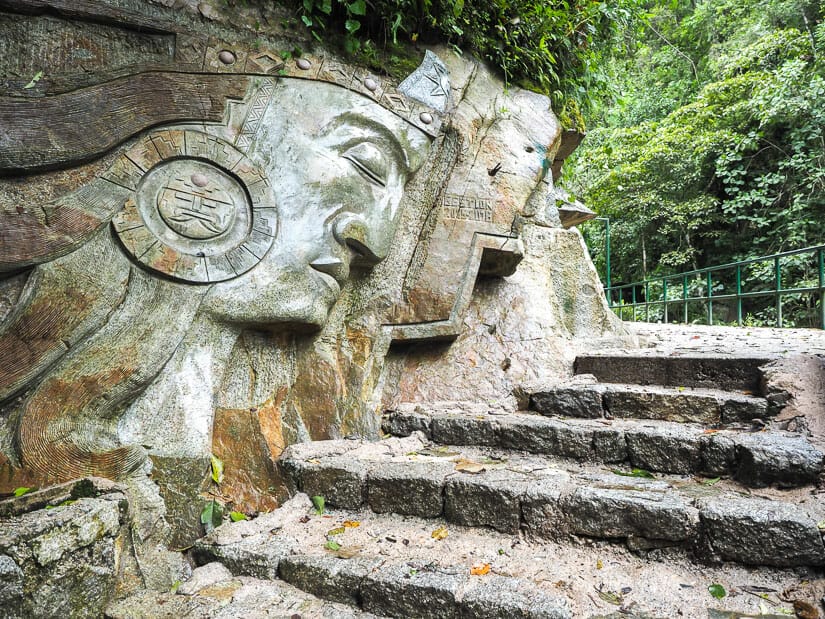
The hot springs are at the northeastern end of town, with restaurant-lined Ave Pachacutec leading there, going slightly uphill. You can rent a towel and/or bathing suit (5 soles each) from shops on the way.
After paying (20 soles, locker included), it’s a 5-minute uphill walk to the pools and changerooms, with some cool stone carvings along the way. You should go down the stairs and change first, then bring your things back up to the locker area, where the attendant will put them in a locker for you and give you the key.
You can also walk another five minutes past the hot spring facility to a series of waterfalls on the river. You may have to open the door beside the hot spring building to access the trail, and the trail is not very well maintained.

Admire Artwork around Town
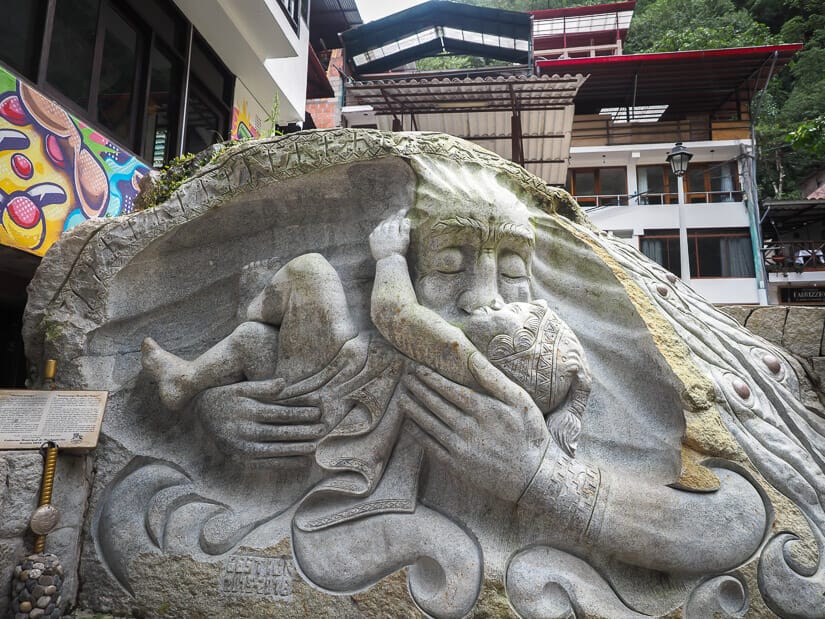
I was pleased to find that there is a lot of public artwork in Aguas Calientes! Most of it is, unsurprisingly, Machu Picchu and Inca themed.
Some of the best artwork can be seen at Parque Wiñaywayna. The park is between Aguas Calientes River and Ave Pachacutec, on the way to the hot springs. The most famous piece there, La familia (Ayllu) Tallado en Piedra, is even marked on GoogleMaps.
The best street art/graffiti in Aguas Calientes can be seen at this spot beside the football field, in the southern/local area of town.
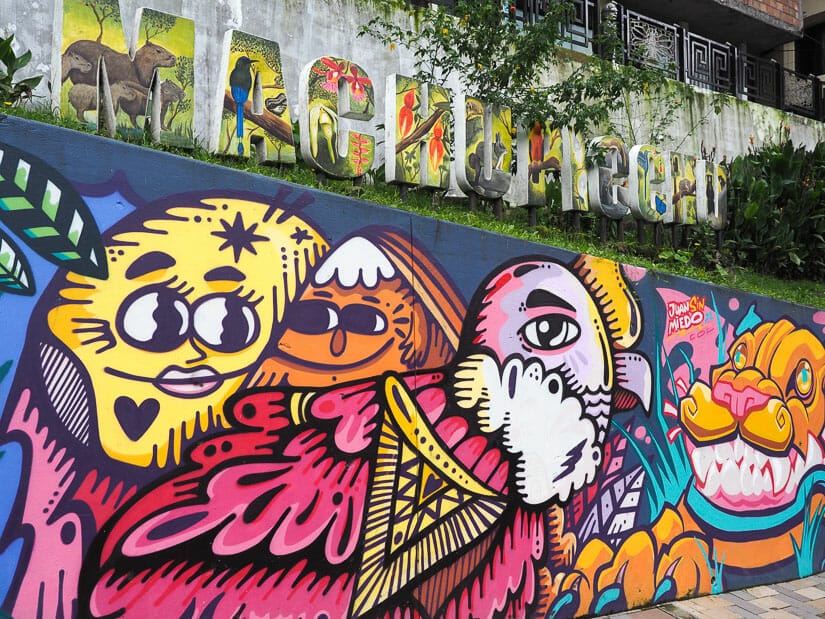
See the Iconic Machu Picchu Signs

You didn’t actually visit Machu Picchu if you didn’t get a picture of the famous sign, right?
There are actually several of these signs. The most convenient and probably most photographed one is located here, right where buses will drop you off when returning to Aguas Calientes from Machu Picchu. However, because tourists are always lingering here, and the sign is very long, you might have to wait a while to get a proper photo of it.
I found a few more very similar signs during my visit. One was located at the graffiti spot I linked to above (see image in previous entry).
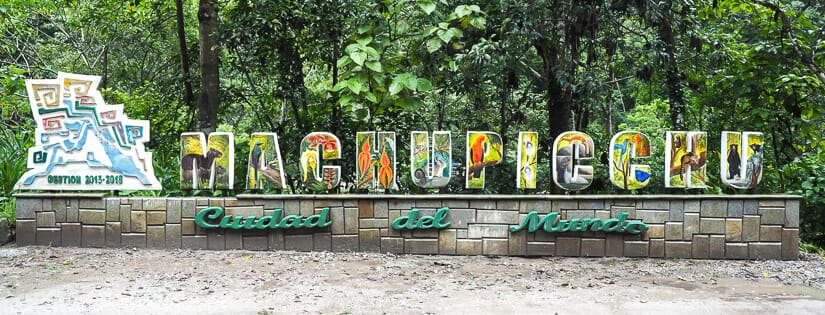
Another was located roughly around here on the train line, if you walk along the train tracks leading out of town in the direction of Machu Picchu. See the cover photo of this article for a shot of it. Please note, after you see that sign, you can’t keep walking much further on these train tracks because you’ll reach a dangerous tunnel that you shouldn’t try walking through.
Yet another Machu Picchu sign is located near Mariposario (Butterfly Center – I’ll cover that in the next section), on the road between Aguas Calientes and Machu Picchu.
Buy Souvenirs in the Mercado Artesanal
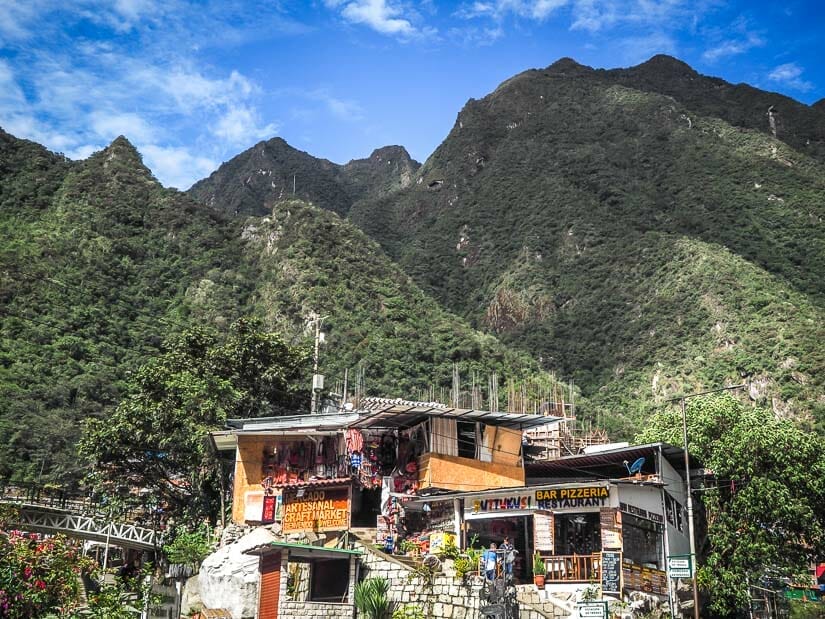
Every backpacker will tell you that the main souvenir market in Aguas Calientes is crap. You can find all the same souvenirs that you’ll see in Cusco and other places in Peru, but they will cost more.
Still, the difference isn’t going to be huge (it will depend on your negotiation skills). So if you see something you want, just go for it. The maze-like Mercado Artesenal is just north of the train station in Aguas Calientes, and you pretty much have to walk through it to get to/from the station. It’s larger than it looks in the above photo.
If you want to actually buy your Machu Picchu souvenirs at Machu Picchu, here’s the closest you’ll get. I’m happy with the T-shirt and fridge magnets I got here.
If you want quality weaved items, though, you’d be much better off visiting Chinchero (a weaving town), Manos de la Comunidad near Cusco, or Awana Kancha (between Cusco and Pisac – see my Pisac guide for info about it).
Shops & Eat Local-Style at Mercado Aguas Calientes

If you want to shop and dine where the locals do, or just experience a local Peruvian market, then Mercado Aguas Calientes is the main one in town. It is conveniently located right next to the Machu Picchu bus station and train line.
The main floor of the market is dedicated to fruits, veggies, and household items. I went here to buy a cheap umbrella when it was pouring rain during my visit. On the second floor, you can find fresh juices and cheap local meals for 6 to 8 soles, a fraction of the price of all the tourist restaurants.
Treat Yourself to a Gourmet Meal

Let’s say you’ve just spent multiple days hiking or a full day visiting Machu Picchu. Chances are the first thing you’ll want to do in Aguas Calientes (after a great shower!) is to treat yourself to a nice meal.
The restaurants in Aguas Calientes are of course mostly tourist-oriented, but that doesn’t mean they’re not all bad. There are several options overlooking the river (see my beer recommendation below). In the evening, many restaurants are dim, with candles on the table, so the vibe is actually quite romantic.
I tried half a dozen restaurants during my stay, and the best meal I had was actually at an Italian restaurant called Incontri del Pueblo Viejo.
There I enjoyed surprisingly legit Italian-style wood-fired pizza. I was seated right beside a round fireplace, which was so lovely and cozy in the cool evening. Go ahead and read the reviews – I’m not the only one was impressed!
If you’re looking to get more than tipsy, you can find some “4-for-the-price-of-1” cocktail deals around town.
Also see my guides to the best restaurants in Pisac and restaurants in Ollantaytambo!
Sample Local Craft Beers at Mapacho

Mapacho Craft Beer Restaurant is an Aguas Calientes institution. For many visitors passing through, this will be their obligatory post-Machu Picchu beer and food stop.
Mapacho has the best list of Peruivian craft beers in town. While they do have some on tap, my first try was decarbonated, so I stuck to bottles after that. There’s also an expansive menu that covers everything from guinea pig and alpaca to burgers and pizza.
The real treat here is the excellent view right next to the Urubamba River, with large windows beside your table that you can choose to open or close. The restaurant entrance is from the street running along the train line.
Besides Mapacho, there are a few other restaurants on the same street with very similar menu, beer selection, and river view.
These include Chullos Restaurant and Craft Beer and Full House Machu Picchu, so if consider checking all three if one is too busy or you can get a spot with river view.
Watch the Trains Go By
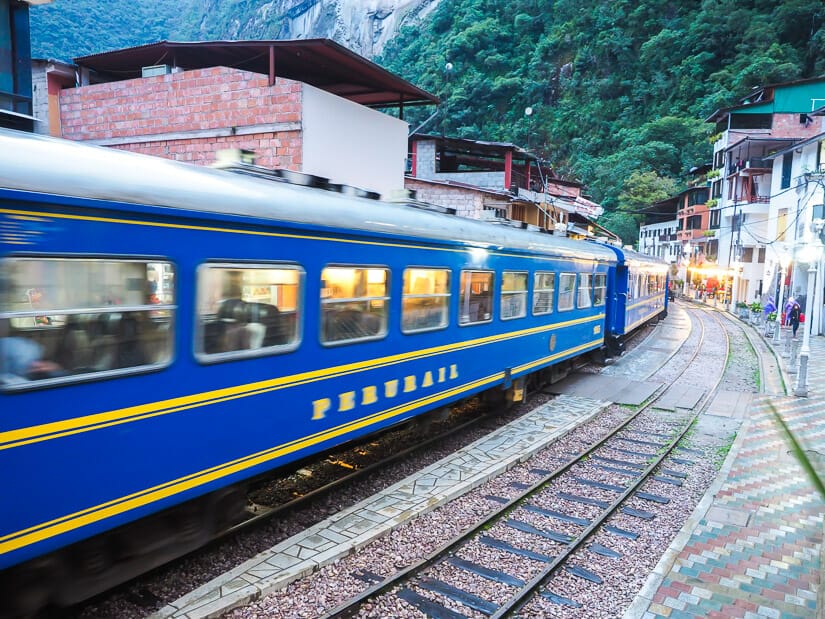
In Aguas Calientes, life revolves around the train line. A couple times per hour, new trains arrive and dump masses of tourists at the station. Some trains continue along the tracks through town, so always look both ways before crossing the tracks.
Several restaurants have patios along the tracks, perfect for trainspotting. There are several options around the Machu Picchu bus station.
One particular restaurant, Café Inkaterra, at the southern end of town, is even sandwiched between two train lines, with trains passing by so close to it that the restaurant shakes. It is an upscale restaurant belonging to Inkaterra hotel, the finest hotel in town.
Stroll through Parque Mirador Río Vilcanota
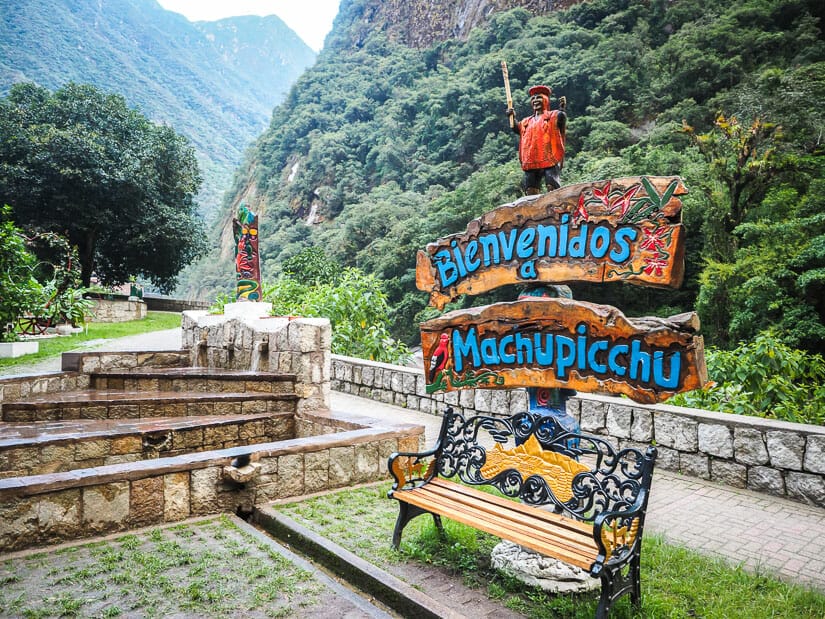
At the western end of town, following the road to Machu Picchu, Parque Mirador Río Vilcanota is a small riverside park that is nice for a quick stroll.
There are some pretty flowers, benches beside the river, and fine views looking upstream back towards town. “Vilcanota” is another name for this section of the Urubamba River.
Places to Visit around Aguas Calientes
Some of the top reasons to spend time in Aguas Calientes are not right in town, but just outside of it. I visited the below five places on foot from Aguas Calientes.
The first is a short hike southeast of town, while the last four could be done in a single trip walking northwest of town.
Alcamayo Waterfall

This lovely waterfall trail is at the southeastern end of Aguas Calientes townsite. You can walk to the trailhead in only 5 minutes from the Aguas Calientes train station or 10 minutes from the Machu Picchu bus station. On the way, don’t miss the cool graffiti I described above.
The walk immediately enters a serene area of forest, following the Alcamayo River upstream. After 10 minutes, you’ll reach a house with many bizarre mudstone statues around it. There you need to by a waterfall entrance ticket for 20 soles and sign in.
From there, it’s another 10 minutes to a small then larger waterfall. In total, the trek too me 45 minutes return and I only saw a couple other people along the way.
Mariposario (Butterfly House)
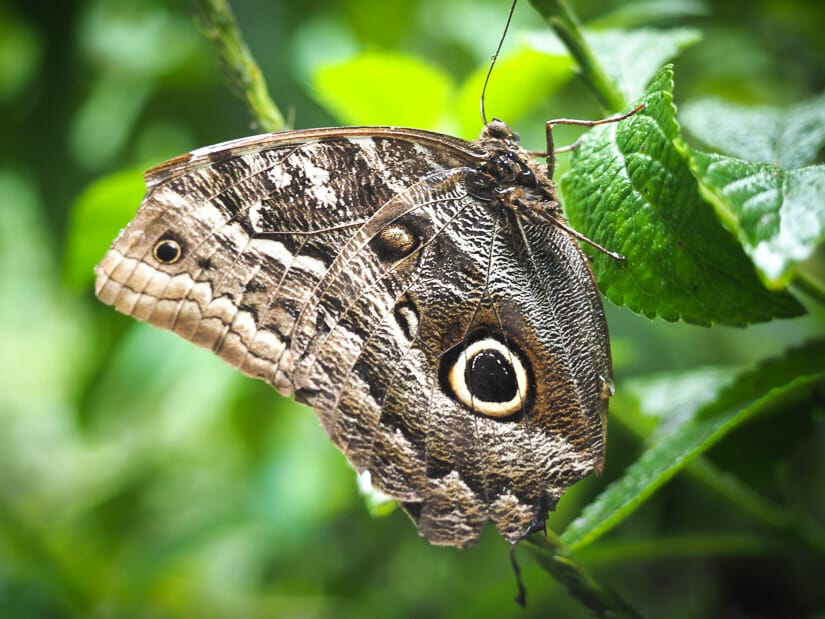
The small Mariposario of Machu Picchu, or Aguas Calientes Butterfly House, is a hidden gem in the area. It was one of my favorite places in Aguas Calientes and more interesting than I had expected.
This butterfly sanctuary has been operating for 50 years. Its main purpose is to preserve the wide variety of butterflies found in the Machu Picchu region.
The 20-sol entrance fee includes a 20-minute tour in English or Spanish. Since I was the only English-speaking visitor when I arrived, I was given a tour by myself and had to wait a few minutes for it to start.

On the tour, the local (Quechua) guide showed me live butterflies at their various stages of development, from eggs (viewed with microscope – I could even see them moving inside) and larva (some were huge!) to pupa and actual butterfly.
I also got to spend time on my own in the large netted butterfly area as well as a garden that attracts a large number of beautiful birds. From the café windows beside it, I could see and photograph the birds up close without bothering them.
The Butterfly House is a 20-minute walk east of town on the road before Machu Picchu, just before it crosses the river and goes steeply uphill to the ruins.
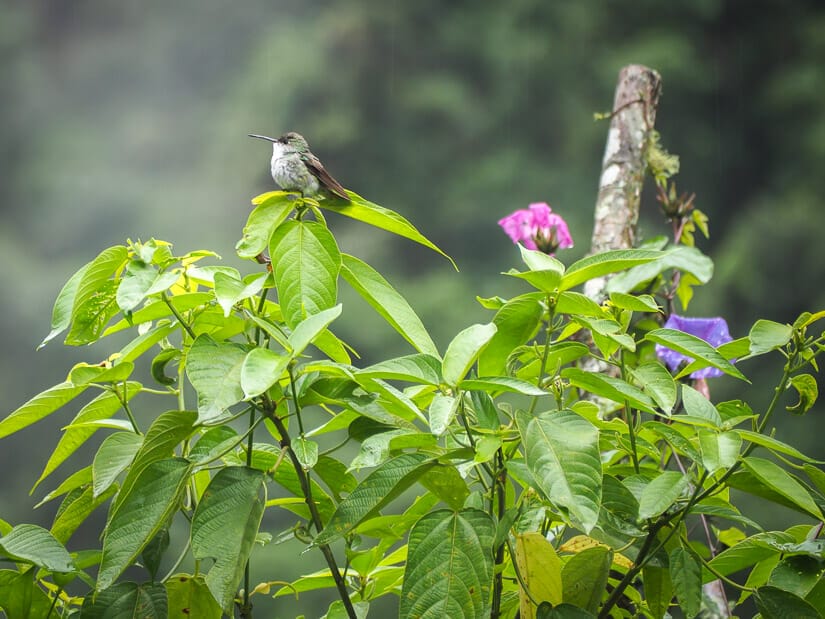
Manuel Chávez Ballón Site Museum
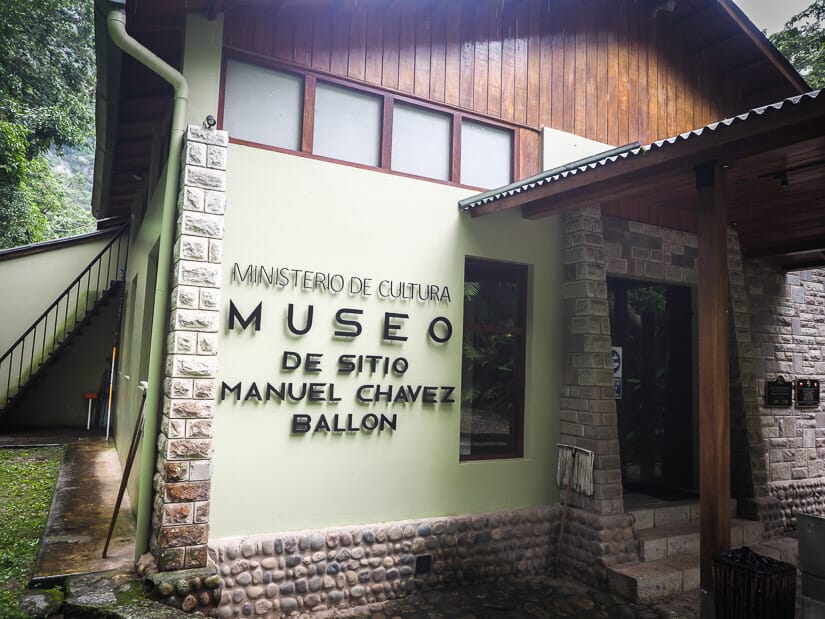
Machu Picchu Museum, or Manuel Chávez Ballón Site Museum, is just five minutes’ walk after the Butterfly House, and one minute past the trailhead of the hike to Machu Picchu.
This small Machu Picchu-focused museum is worth 20 minutes of your time. It is free to visit if you show a Machu Picchu ticket for that day, or 22 soles if you don’t have one.
In the museum you can see some of the first maps of Machu Picchu, the original National Geographic that made Machu Picchu (and the magazine itself) famous, and some Inca artifacts. Chávez Ballón is considered the father of modern Cusco region archaeology and the museum has been around for four decades. No photography is allowed inside.
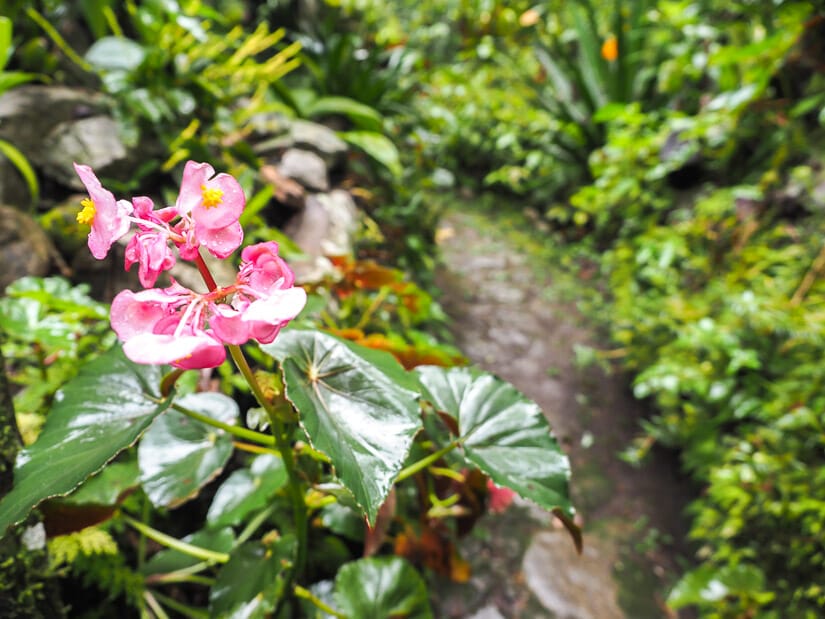
Right beside the museum, there’s a small botanical garden with a short, 5-minute loop trail through it. You’ll see an original Inca wall and lots of cool flowers and plants.
To reach the museum from Butterfly House, you’ll need to cross the pedestrian bridge over the river, where the guard may ask to see a Machu Picchu ticket. You can just say you’re going to the museum. After crossing the bridge, turn right. You’ll see the Machu Picchu hike trailhead. The museum is just one minute past it.
There’s also a simple restaurant just before the bridge with drinks and tasty empanadas.
Learn about other museums in the region in my Cusco museums guide.
Hiking Trail to Machu Picchu
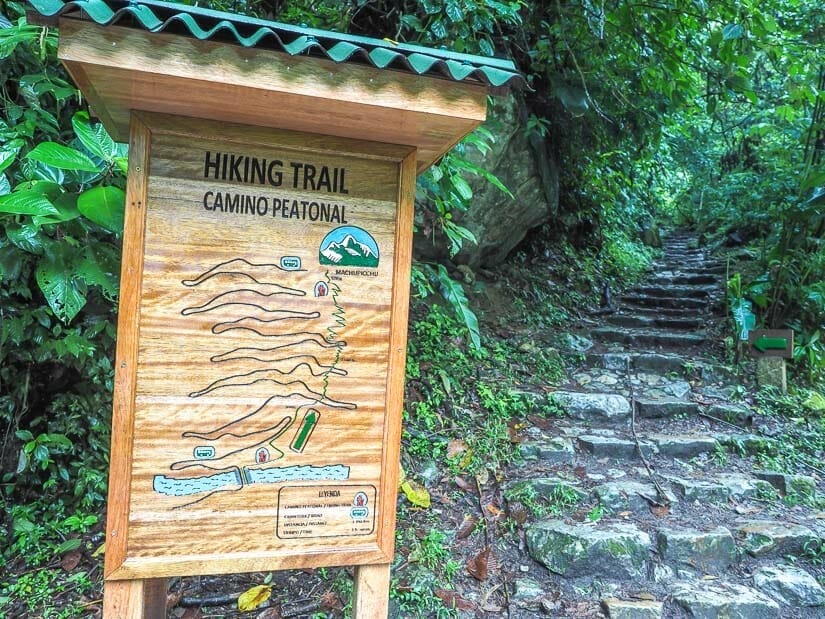
It’s worth noting that the hike to Machu Picchu starts here, at the end of the bridge across the Urubamba River.
If you want to skip the ridiculous US$24 twenty-minute bus ride to Machu Picchu, you can hike up here. But the hike is not easy. This is gruelling, steeply uphill, 1 hr 40 min hour climb through the forest. It crosses the winding Hiram Bingham Highway, which the buses take up, several times on the way up.
You may have to show your Machu Picchu entrance ticket at the guard station before crossing the bridge. You aren’t supposed to pass this point more than two hours before your Machu Picchu entrance time, but you could also say you’re going to the museum.
Mandor Gardens & Waterfall

The furthest place I’m going to introduce, but still easy walking distance from Aguas Calientes, is Mandor Gardens and Waterfall (Los Jardines de Mandor y Catarata de Mandor).
There is actually some history behind Mandor. It was around here at Mandor Pampa that Hiram Bingham first learned that Machu Picchu ruins were nearby. An innkeeper from there led Bingham up to the Machu Picchu site.
Today’s Mandor is along the train line from Aguas Calientes to Hydroelectrica. The line follows the Urubamba River around three sides of Machu Picchu. The owners of Mandor have turned a piece of land here into a preservation area in order to encourage the return of native plants and animals.

Arriving at Mandor, you’ll see a building on the left of the train tracks, which is a restaurant, simple hotel, and ticket office. Entry to Mandor costs 20 soles, and you can leave your luggage there if you need to. After buying the ticket, cross the tracks and go through the gate.
Just inside, there’s a set of cabins in the forest, also available for rent. They looked to me like the perfect place to chill for a few days!
On the 40-minute return walk to Mandor Waterfall, the first half was originally cleared for building the railway line and a banana plantation. This is where they are currently replanting native species. The upper half around the waterfall is original forest, which you can tell because it is denser.
On the trail, you can expect to see some cool flowers and birds. There are also some fountains with meditation spots and a few swimming spots on the river (the water was too wild for swimming when I visited due to lots of recent rain). The waterfall itself is stunning.
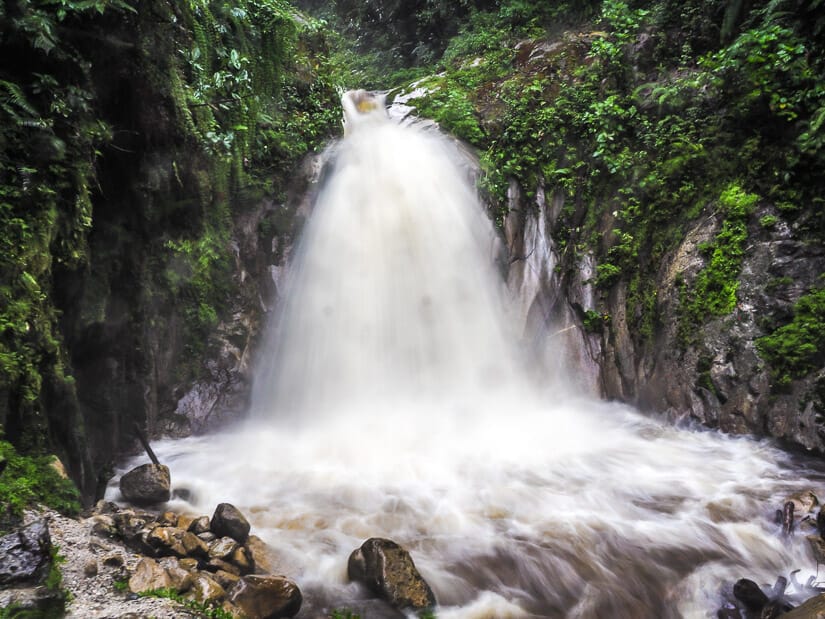
Mandor is a one-hour walk from Aguas Calientes. To get there, first walk to Butterfly House. While it may be tempting to just walk the train line all the way from town, you can’t due to a a dangerous tunnel just west of town. I tried, but there were signs saying it’s not allowed, so I had to turn back and walk along the road.
Just past Butterfly House, turn right up a small road on the opposite side and follow it to Puete Ruinas Train Station. Alternatively, if you want to go to Manuel Chávez Ballón Site Museum first like I did, after visiting the museum, go back across the small bridge, then take the stairs behind the small restaurant to reach the train station.
From the train station, you’ll walk along the train tracks for 30 minutes to reach Mandor. There are a few small eateries along the way, and the scenery is lovely. There is enough space on the side for when trains pass by.
In total, you can budget 2.5 to 3 hours to visit Mandor Waterfall from Aguas. Add another 1 to 1.5 hours if you plan to visit Buttefly House and Manuel Chávez Ballón Site Museum as well.
You’ll notice a steady stream of backpackers walking along the train line. These are budget travelers who took a colectivo from Cusco to Hydroelectrica and are walking in to Aguas Calientes or Machu Picchu, in order to skip the expensive train ride.
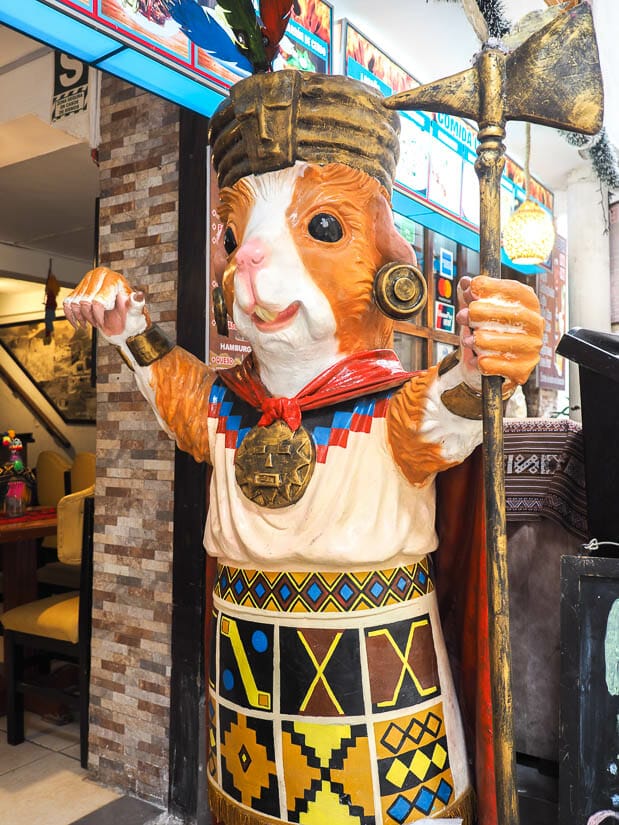
That brings us to the end of this Aguas Calientes guide! I hope you’ve found even more information than you needed here. Also check out my guides to Ollantaytambo ruins, Pisac ruins, and other ruins around Cusco!

